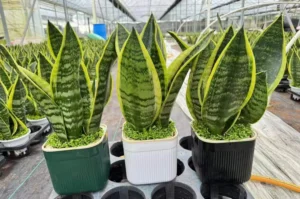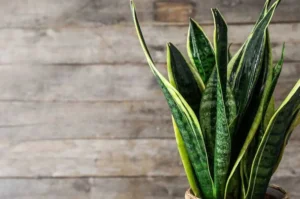Snake plants, often known as mother-in-law’s tongue, are loved for their strong, upright leaves and easygoing nature. But while they’re known for being low-maintenance, many snake plant owners unknowingly follow wrong advice that slowly damages their plant.
In this guide, we’ll break down five common myths about snake plant care that might be doing more harm than good, and what to do instead. If your plant isn’t growing well or its leaves look weak, these tips will help you fix it.
Myth 1: Snake Plants Don’t Need Water at All
What’s Wrong With This Belief:
Many people think snake plants can go months without water, but that’s not true. While they don’t need frequent watering, they still need water to stay alive.
Reality Check:
Snake plants store water in their leaves and roots, which helps them survive dry spells. But if they stay dry for too long, their leaves can start to wrinkle, curl, or even turn brown at the tips.
Better Care Tip:
Water your snake plant every 2–3 weeks during the warmer months. In winter, cut back and only water when the soil feels completely dry. Always feel the top two inches of soil before watering.
Myth 2: Snake Plants Can Live in Complete Shade
Why This Can Be a Problem:
Yes, snake plants are tough and can survive in low-light rooms—but “survive” doesn’t mean “thrive.” When placed in dark areas, their growth slows down and their color may fade.
What’s Actually True:
Snake plants grow best with bright, indirect sunlight. A little bit of daily light keeps their leaves firm, upright, and vibrant.
Smart Tip:
Place your snake plant near a window that gets filtered light. North or east-facing windows are usually a good spot. Rotate the pot every week or two so all sides get light evenly.
Myth 3: Snake Plants Love Humid Environments
The Problem With This Idea:
Some people think snake plants need humidity like tropical plants, so they mist them or place them in bathrooms. This can lead to rot and fungus.
The Truth:
Snake plants prefer dry air, just like their natural habitat in West Africa. Humid environments can trap moisture in the soil or on the leaves, creating the perfect conditions for root rot and leaf spots.
How to Fix It:
Keep your snake plant in a space with average indoor air. No misting is needed. Avoid bathrooms or placing them near humidifiers. A cool, dry spot is best.
Myth 4: Snake Plants Should Be Repotted Every Year
Why This Can Hurt Your Plant:
Repotting too often can shock the roots, disturb the soil, and slow the plant’s growth. Snake plants don’t like too much change.
What’s Real:
These plants are happy staying root-bound for years. Unless the roots are breaking through the pot or the plant is falling over, there’s no need to repot.
Best Practice:
Repot your snake plant every 2–3 years or when it clearly outgrows its pot. Use a container with drainage holes and a cactus/succulent soil mix that drains well.
Myth 5: Snake Plants Don’t Need Any Fertilizer
Why This is Misleading:
While snake plants can survive with little feeding, completely skipping fertilizer means they miss out on nutrients that support healthy leaves and root development.
What’s Actually Right:
Feeding your snake plant during the growing season helps it grow taller and stronger. Without it, you may notice weak, pale, or slow-growing leaves.
What You Should Do:
Apply a mild liquid fertilizer once a month in spring and summer. Use half the recommended amount to avoid overfeeding. Don’t fertilize during fall or winter when the plant is resting.
Extra Tips to Keep Your Snake Plant Thriving
- Dust the leaves occasionally to help them absorb light better.
- Avoid overwatering, which is the most common reason snake plants die.
- Use a well-draining soil to keep the roots healthy.
- Keep them away from cold drafts in winter.
Final Thoughts
Snake plants may be tough, but they’re not invincible. If you’ve been following some of these common care myths, it might explain why your plant isn’t doing well. Thankfully, the fixes are simple.
Give your snake plant the right balance of water, light, and care, and it will reward you with fresh growth and clean air for years to come. Trust your eyes and feel the soil — every plant is different, and with a little attention, your snake plant can thrive in any home.






